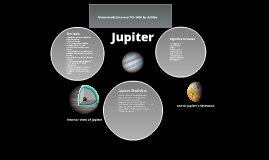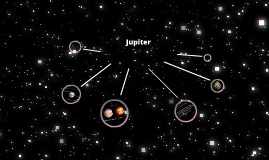Jupiter Presentation
Transcript: Jupiter Morgan and Natalie History History Jupiter was named after the king of the gods in Roman mythology, Zeus. Jupiter helped revolutionize the way astronomers saw the universe in 1610, when Galileo discovered Jupiter's four large moons- Io, Europa, Ganymede and Callisto, now known as the Galilean moons. This was the first time that celestial bodies were seen circling an object other than Earth, and gave major support to the Copernican view that Earth was not the center of the universe. Jupiter's Geology Geology The composition of Jupiter is similar to that of the Sun-mostly hydrogen and helium. Deep in the atmosphere, pressure and temperature increase, compressing the hydrogen gas into a liquid. It is still unclear if, deeper down, Jupiter has a central core of solid material or if it may be a thick, super-hot and dense soup. This gives Jupiter the largest ocean in the solar system—an ocean made of hydrogen instead of water. There is no firm surface on Jupiter, so if you tried to stand on the planet, you sink down and be crushed by the intense pressure inside the planet. Atmosphere Atmosphere The gas planet likely has three distinct cloud layers in its "skies" that, taken together, span about 44 miles (71 kilometers). The top cloud is made of ammonia ice, while the middle layer is likely made of ammonium hydrosulfide crystals. The innermost layer may be made of water ice and vapor. Jupiter's fast rotation-spinning once every 10 hours-creates strong jet streams, separating its clouds into dark belts and bright zones across long stretches. Pictures Pictures Jupiter's Formation Formation Jupiter took shape when the rest of the solar system formed about 4.5 billion years ago, when gravity pulled swirling gas and dust in to become this gas giant. Jupiter took most of the mass left over after the formation of the Sun, ending up with more than twice the combined material of the other bodies in the solar system. In fact, Jupiter has the same ingredients as a star, but it did not grow massive enough to ignite. Jupiter's Location Jupiter is the fifth planet from the Sun and the largest in the Solar System. It is a gas giant with a mass more than two and a half times that of all the other planets in the Solar System combined, but slightly less than one-thousandth the mass of the Sun. About 4 billion years ago, Jupiter settled into its current position in the outer solar system, where it is the fifth planet from the Sun. Location Fun Facts Fun Facts - New research by scientists apparently shows that it rains diamonds on Jupiter and Saturn. According to the research, lightning storms on the planets turn methane into soot which hardens into chunks of graphite and then diamonds as it falls. -Jupiter's magnetic field Is 14 Times Stronger Than Earth's

















